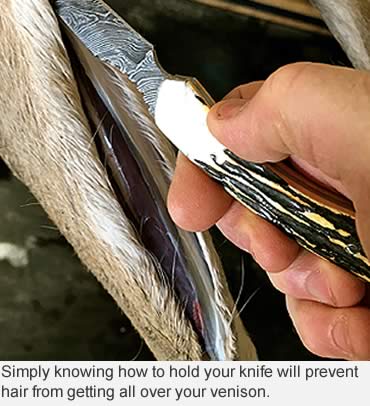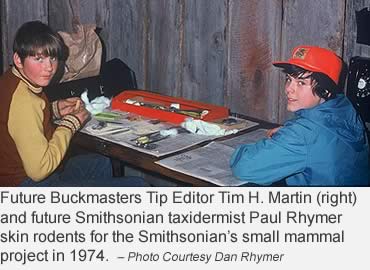By Tim H. Martin
I learned a lot about skinning animals from hanging with world-class taxidermists most of my life. Several of my best friends are award-winning “taxis” who have created mounts any sportsman would drool over.
In 1974, when I was 11 years old, my best friend’s father, Dan Rhymer, was a taxidermist for The Smithsonian Institution.
One winter’s weekend, Dan taught his son Paul and me the basics of using a knife on delicate animal skins, and he allowed us to contribute to a special museum project.
The objective was to preserve and study skins of small mammals, such as numerous mouse, shrew and vole species of the American Northeast.
 There were plenty of rodents to be found in the deep woods surrounding their home in Maryland’s Rock Creek Regional Park, and we had a ball catching them with mousetraps baited with a little dab of peanut butter.
There were plenty of rodents to be found in the deep woods surrounding their home in Maryland’s Rock Creek Regional Park, and we had a ball catching them with mousetraps baited with a little dab of peanut butter.
We stuffed the rodent skins with wire and cotton, and are they are preserved in the Smithsonian’s archives to this day.
As you might’ve already learned the hard way, if you cut skin with the blade-side down, any hair lying across the incision line will be sliced along with the skin, and severed fur will go everywhere.
Dan showed us the secret to preventing hair from being cut, too, and it applies to everything from white-tailed deer to wildebeest.
This technique prevents hair shavings from getting all over your venison, and gives your taxidermist a perfect seam to stitch on your trophies.
 Simply grip your knife (or scalpel) upside down, with the blade turned upward. Poke the point through the skin and run it along the incision line. Since you are slicing from the opposite side of the hair, it cannot be cut.
Simply grip your knife (or scalpel) upside down, with the blade turned upward. Poke the point through the skin and run it along the incision line. Since you are slicing from the opposite side of the hair, it cannot be cut.
For deer and thick-skinned animals, place the pointer finger of your free hand against the back (dull side) of the knife tip and push the knife tip along the incision line. The fingertip gives a little extra force for pushing the knife through muscle (when gutting) and tough animal hides.
Editor’s Note: Bear & Son Cutlery produced the handsome knife in our photo. This caper/hunter model features a Damascus steel blade with a genuine India stag bone handle. And, it was made in the U.S.A.!
www.bearandsoncutlery.com
Editor’s Note: If you have a unique or special tip you’d like to share with Buckmasters fans, please email it to huntingtips@buckmasters.com and, if chosen, we will send you a cap signed by Jackie Bushman, along with a knife!
Read Recent Tip of the Week:
• Ladder Lover’s Leg Tip: Metal ladders are one of the quietest, most easily accessible and effective stands hunters can use. Here’s a tip if a leg joint gets squeaky.